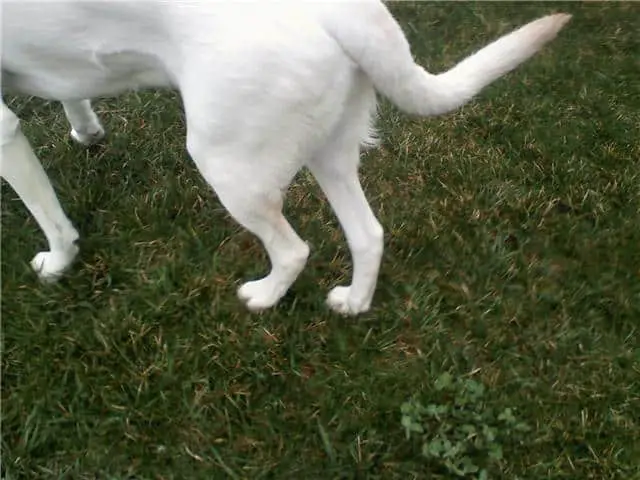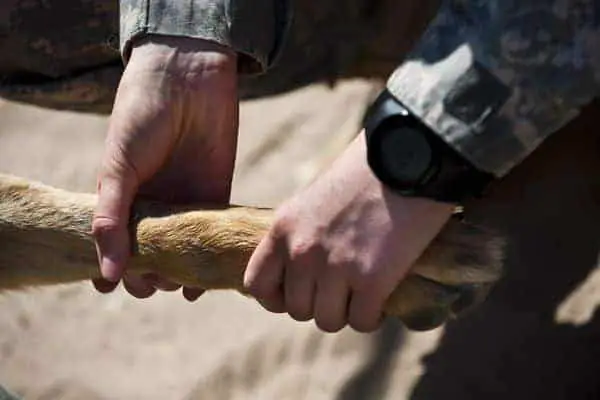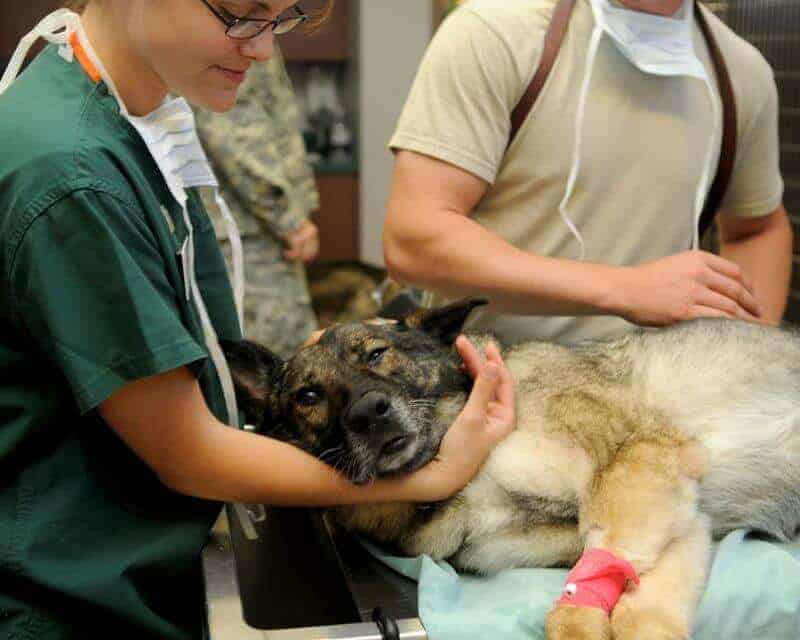Almost everyone has heard of hip dysplasia – an uncomfortable and dangerous problem that occurs in certain breeds of dogs. This malformation of the hip socket is the biggest cause of rear leg lameness in dogs. It causes painful
canine arthritis and many other problems, and happens most often in larger breeds. It’s one of the best studied veterinary conditions in our canine companions, since it’s also the most common cause for hip arthritis.
At Risk Breads
Certain breeds of dogs are more known for hip dysplasia than others. Most people have heard that Golden Retrievers,
Mastiffs, Labradors and
German Shepherds are prone to this problem, but may not know that other purebred medium, large, and giant breed dogs can get it. Even less common is the knowledge that smaller dogs may have hip dysplasia.
According to the
Orthopedic Foundation for Animals, or OFA, the breed most likely to have hip dysplasia is actually the Bulldog. Up to three quarters of
bulldogs have some kind of malformation in the hip joint on x-rays. They won’t all suffer serious arthritis or similar problems, but this breed does often have dysplastic hips. Pugs are actually the second most likely to suffer from this problem, with more than sixty percent of dogs x-rayed showing problems.
Spaniels, terriers, and the French and American Bulldog all have problems with their hips, as well. In fact, seven out of the twenty breeds at highest risk for hip dysplasia weigh less than fifty pounds, and have a greater than thirty percent chance of having problems with their hips. It’s not really only large breeds or German Shepherds that have hip trouble.
Labs, Great Danes,
Rottweilers, Golden Retrievers and German Shepherds are all famous for their high incidence of hip dysplasia, and it’s true that it’s a danger. But is it really as bad as the reputation? Only about twelve percent of Labs x-rayed showed dysplasia. Great Danes came in around eleven percent, and only about twenty percent of Rottweilers, German Shepherds, and Golden Retrievers have this problem. Does that mean they’re not at risk? Of course not – but it does mean the problem isn’t as bad as their reputation might suggest.
Some people claim that mixed breeds are less likely to suffer from this problem, but that’s not really true. It all depends on the dog, and the mix it’s made up of. We just don’t have good statistics on mutts and their incidence of dysplasia, since breeders are the only ones keeping good records. If you buy from a pet shop, adopt from a friend, or get a dog from a shelter, you don’t really know what the results will be.
If you have a breed that’s prone to hip dysplasia, it’s important to treat your dog correctly as he or she is growing. The right nutrient balance, caloric intake, and frequency and type of exercise are all extremely important. The wrong ones could cause greater amounts of damage to your pet.
What Causes Hip Dysplasia in Dogs?
The cause of hip dysplasia is straightforward in itself – it is caused by the subluxation in the joint of the hip. The abnormal rate of wear and tear from such subluxation results to pain, discomfort and other symptoms similar to arthritis. Although veterinary science has yet to identify the exact risk factors for dog breeds, initial research has pinpointed these factors:
- Genetics – If a dog has dysplasia, its offspring has higher risks for developing the joint disease. Conversely, if both parents of a dog do not have hip dysplasia, then it will likely be free of the symptoms. Breeders have noted that the incidence of hip dysplasia can either be raised or lowered through selective breeding but complete elimination within a specific breeding line is virtually impossible.
- Nutrition – Canine diet with too little or too much calcium has been shown to increase the risks for joint diseases including hip dysplasia. Owners must carefully monitor their dogs’ diet to ensure that it contains the right nutrients in the right amount for the canines’ age.
- Exercise – If an at-risk dog as mentioned above is subjected to too much exercise at a young age, the risks for hip dysplasia increase. This is also true for other types of exercise that exerts excessive force on the joints such as playing Frisbee.
There are people who believe that vaccinations cause hip dysplasia, whether in the dog being vaccinated or their puppies. There is currently no scientifically backed evidence to confirm that is the case at this time.
How Hip Dysplasia Works
A normal dog’s hip is made up of the joint of the head of the femur, which is nearly round, and a concave socket in the pelvis. The ends of both bones are covered by cartilage, giving the dog a full range of motion. However, dogs that have hip dysplasia don’t have a normal hip. Instead, the head of the femur doesn’t fit deeply or tightly into the socket. The socket and femur are also out of round, and can be misshapen. These lead to a partial or loose fit of the joint, and friction and abnormal wear in the hip.
Of course, the body will react to this in a number of different ways, trying to repair itself by laying down enough protective new cartilage. However, this process is slow, and may not occur as fast as the damage is being done. Plus, the more damage that occurs, the harder it is for the joint to resist additional damage. The joint deformity may even become worse over time.
Most of the time, animals that have this problem will try to avoid moving their hips too much. After all, movement hurts! This can be done by moving both legs together, producing a run that looks more like a rabbit hopping. Dogs trying to minimize movement may also move less dynamically, or move stiffly. Sometimes, avoiding movement in the hip can cause problems in other places, too. Dogs that can’t move their hips fully may use their spine and other joints differently.
This means that a dog that has hip dysplasia may also present with problems in the stifle (the knee), the spine, or in muscles or other soft tissue. In fact, these problems might be apparent before you realize that the hips are really the cause. Many owners don’t know that their dogs have hip problems until they become severe.
Symptoms of Dog Hip Dysplasia
Unfortunately, dogs of all ages are susceptible to hip dysplasia with many cases of five-month old puppies showing the signs of the joint disorder in its most severe form. The symptoms will worsen over time without the proper treatment until all daily activities even walking cannot be performed without considerable pain on the dog’s part. The final result is the inability to walk, which may or may not be observed soon after the first symptoms were manifested in the dog.
The symptoms are very similar to canine arthritis, thus, underlining the importance of seeking veterinary advice for a definitive diagnosis and appropriate treatment. Also, the following symptoms will vary in terms of intensity and progress from one dog to the next: walking and running with an altered gait (bunny hopping, as owners call it); resistance to movements requiring the full extension and flexion of the rear legs; signs of stiffness, discomfort and pain emanating from the rear legs; and loss of muscle tone requiring assistance in getting up.
Diagnosis
Diagnosis for canine hip dysplasia is a combination of medical history, complete physical examination and radiographs in the form of x-rays. The veterinarian will ask questions regarding the visible symptoms as mentioned above as well as the family and medical history of the dog. Said interview of the owner will be coupled with a physical examination of the dog itself such as feeling for any sign of looseness in the joint and extension/flexion exercises.
The x-rays are used to confirm the initial diagnosis of hip dysplasia. Changes in normal joint structure are observed so as to generate a more definitive diagnosis about the degree of the dysplastic condition. Appropriate treatment can then be provided. There are two other testing methods used by breeders to determine if a dog is at high risk for hip dysplasia. First, the OFA method which requires x-rays to be taken, of which the films are then submitted for analysis to the Orthopedic Foundation for Animals (OFA). Second, the newer method is the PennHIP method where unique radiographic views of the canine’s hips are analyzed for joint laxity by trained veterinarians.
Treatment
Depending on the severity of the hip dysplasia, a veterinarian may choose to adopt the medical or surgical route to treat the joint disease. It is important to discuss the options as each one has its pros and cons.
Let’s discuss the medical methods first. Most veterinarians will take this route mainly because of the lesser costs involved as well as the good response rate.
- Maintenance of a healthy weight though proper diet and light exercise as well massage and physical therapy
- Oral supplements like glucosamine and chondroitin may also be given to manage the symptoms of osteoarthritis and hip dysplasia
- Omega-3 fatty acids are good supplements for the management of canine atrophy
- Other supplements include duralactin, methyl-sulfonyl-methane (MSM), S-Adenosyl-L-methionine (SAMe, Denosyl SD4), polysulfated glycosaminoglycan hyaluronic acid
- Anti-inflammatory drugs like carprofen, etodolac and meloxicam as well as corticosteroids
Surgical procedures are considered as the last resort. These procedures include Triple Pelvic Osteotomy (TPO), Juvenile Pubic Symphysiodesis and Total Hip Replacement. Triple Pelvic Osteotomy (TPO) involves breaking the pelvic bones, then realigning the femoral head and correcting the subluxation. Juvenile Pubic Symphysiodesis involves fusing the pelvic bones in young dogs, thus, allowing these bones to develop in a normal manner. Total hip replacement is a radical procedure involving the removal of the diseased joint and then replacing it with prosthesis. This has a high success rate with dogs returning to their daily activities without the pain.
The treatment options must be carefully considered from the onset lest health complications manifest from the inaction on the owner’s part. Said complications include other degenerative joint diseases like osteoarthritis as well as hip fractures, both of which can lead to total disability.








